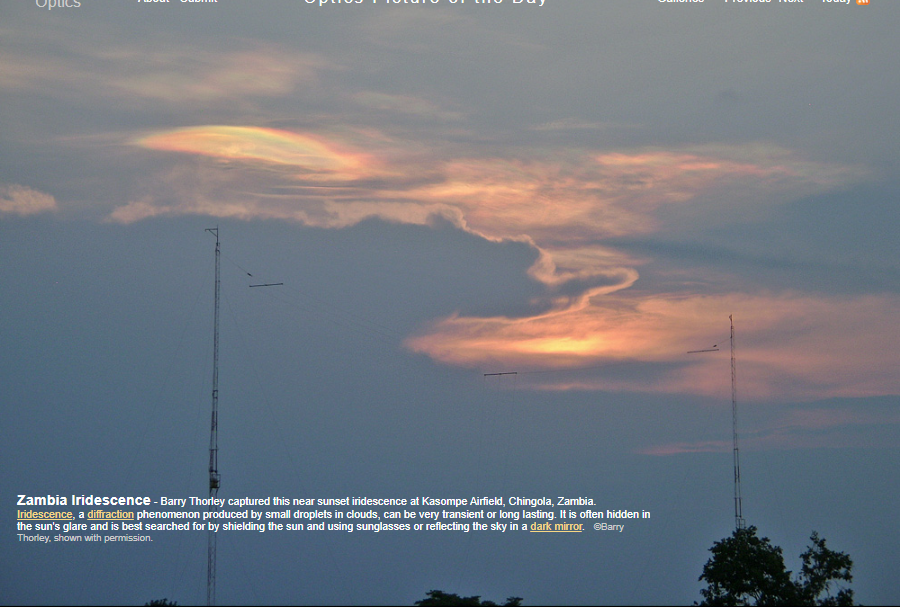Zambia Sky Colours
Zambia Sky Colours: A Captivating Display of Atmospheric Phenomena
The beautiful country of Zambia is not only known for its diverse wildlife and stunning landscapes but also for the captivating display of sky colors that can be witnessed throughout the year. From iridescence to sundogs, these atmospheric optics phenomena add a touch of magic to the Zambian skies. In this article, we will delve into the enchanting world of Zambia sky colors and explore the science behind these mesmerizing displays.
Iridescence: A Transient Spectacle
One of the most intriguing atmospheric optics phenomena observed in Zambia is iridescence. This phenomenon occurs when small droplets in clouds diffract sunlight, creating a vibrant display of colors. Iridescence can be highly transient, appearing for only a few moments, or it can linger in the sky for longer durations. Often hidden within the glare of the sun, spotting iridescence requires some effort. Shielding the sun with your hand or using sunglasses can help reveal this elusive spectacle. Another method is to use a dark mirror to reflect the sky and search for the iridescent hues.
Sundogs: Twin Flames in the Sky
Sundogs, also known as parhelia, are another captivating sight that graces the Zambian sky. These bright spots of light appear on either side of the sun and create a stunning halo effect. Sundogs are caused by the refraction of sunlight through ice crystals in the atmosphere. These crystals act as prisms, bending the sunlight and creating a dispersion of colors. The result is a pair of fiery orbs flanking the sun, adding a touch of celestial beauty to the Zambian landscape.
The Enigma of Halos
Halos are yet another atmospheric optical phenomenon that often paints the Zambian sky with a haloed glory. These luminous rings encircle the sun or the moon, creating a mystical aura. Halos are formed when light is refracted and reflected by ice crystals in the atmosphere. These crystals act as tiny prisms, bending the light and causing it to disperse into its component colors. The result is a mesmerizing display of circular hues that seem to encase the celestial bodies.
Rainbow Delights: A Vivid Arch of Colors
Rainbows are a universally cherished sight, and Zambia is no exception when it comes to these enchanting arcs of color. Rainbows occur when sunlight is refracted, reflected, and dispersed by water droplets in the atmosphere. As the light passes through the droplets, it undergoes multiple internal reflections and refractions, resulting in the separation of colors. The result is a magnificent arc of vibrant hues stretching across the sky, captivating all who gaze upon it.
Crepuscular Rays: Beams of Radiance
Crepuscular rays, also known as "God rays," are a celestial spectacle that often graces the Zambian sky during sunrise or sunset. These beams of radiance appear to emanate from the sun, streaming through gaps in the clouds or between objects on the horizon. Crepuscular rays are caused by the scattering of sunlight by particles in the atmosphere, such as dust or water droplets. The beams of light create a mesmerizing effect, seemingly illuminating the sky with divine luminescence.
Twilight's Palette: Golden Hour and Blue Hour
The Zambian sky also offers breathtaking displays during the golden hour and blue hour. The golden hour refers to the period shortly after sunrise or before sunset when the sun casts a warm golden glow across the landscape. This magical lighting creates a serene and ethereal atmosphere, bathing everything in a soft, golden hue. On the other hand, the blue hour occurs just before sunrise or after sunset when the sky takes on a deep blue color. This enchanting period provides a captivating backdrop for photography and evokes a sense of tranquility.
Understanding the Science Behind the Spectacle
To truly appreciate the captivating sky colors of Zambia, it is essential to understand the science behind these atmospheric phenomena. The interaction of sunlight with particles and droplets in the atmosphere gives rise to the diffraction, refraction, and reflection of light, leading to the creation of vibrant colors. The size, shape, and composition of these particles and droplets play a crucial role in determining the specific optical effects observed in the sky. By unraveling the scientific principles at play, we can gain a deeper appreciation for the beauty that nature paints across the Zambian heavens.
Embracing the Wonder of Zambia Sky Colors
The captivating sky colors of Zambia offer a truly awe-inspiring experience for both locals and visitors alike. From the elusive iridescence to the radiant sundogs, each atmospheric optics phenomenon adds a touch of magic to the Zambian landscape. Whether it's capturing the golden hour or marveling at a rainbow stretching across the horizon, embracing the wonder of Zambia sky colors is an invitation to connect with nature's captivating beauty. So, next time you find yourself gazing at the Zambian sky, take a moment to appreciate the intricate dance of light and particles that creates these enchanting displays.

Zambia Iridescence - Barry Thorley captured this near sunset iridescence at Kasompe Airfield, Chingola, Zambia. Iridescence, a diffraction phenomenon produced by small droplets in clouds, can be very transient or long lasting. It is often hidden in the sun's glare and is best searched for by shielding the sun and using sunglasses or reflecting the sky in a dark mirror. ©Barry Thorley, shown with permission.
Note: this article has been automatically converted from the old site and may not appear as intended. You can find the original article here.
Reference Atmospheric Optics
If you use any of the definitions, information, or data presented on Atmospheric Optics, please copy the link or reference below to properly credit us as the reference source. Thank you!
-
<a href="https://atoptics.co.uk/blog/zambia-sky-colours/">Zambia Sky Colours</a>
-
"Zambia Sky Colours". Atmospheric Optics. Accessed on November 26, 2024. https://atoptics.co.uk/blog/zambia-sky-colours/.
-
"Zambia Sky Colours". Atmospheric Optics, https://atoptics.co.uk/blog/zambia-sky-colours/. Accessed 26 November, 2024
-
Zambia Sky Colours. Atmospheric Optics. Retrieved from https://atoptics.co.uk/blog/zambia-sky-colours/.